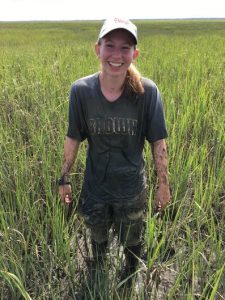
Hallie Fischman is an Environmental Engineering Sciences PhD student in the Angelini Ecology Lab studying the restoration of coastal ecosystems. She is currently researching how facilitation and mutualistic interactions can improve coastal restoration. Hallie’s been busy in the field recently, planting dune grasses as part of a restoration study, and she took a break from the dunes to provide us with an update and a summary of her work.
Sand dunes are highly diverse ecosystems with over 80 different species of plants growing along Florida beaches. This diversity enhances sand dune recovery from storms and supports native wildlife. But, a single dune grass species has gained the majority of attention from beachgoers and restoration practitioners alike. Sea oats (Uniola paniculata) are an iconic coastal grass familiar to many Florida residents and praised for their aesthetics and dune stabilization abilities. While sea oats are important dune builders, they are not the only species capable of this role.

Bitter panicgrass (Panicum amarum) is another native dune grass species that is as prevalent as sea oats along the Florida coast. Importantly, panicgrass commonly grows in highly disturbed areas such as along beach walkways and in storm-damaged dunes. However, panicgrass is infrequently planted during restoration attempts because the majority of restoration efforts in the region plant only sea oats. With this project, we are testing if panicgrass can be included in sand dune restoration plantings to improve restoration outcomes. Because panicgrass is more common in disturbed areas of sand dunes, we hypothesize that it may act as an early succession species, priming a damaged area for the later colonization of sea oats. Based on this hypothesis, planting panicgrass before sea oats may improve the survival of planted dune grasses and their ability to build dunes that protect against storm flooding.
To test this hypothesis, I planted 2,000 individual plugs of sea oats and panicgrass at seven beaches between St. Augustine and New Smyrna Beach. I will monitor these plantings for the next three years to evaluate the survival, growth, and sand-trapping ability of panicgrass and sea oats when planted together and separately. I will add additional plants over the course of this experiment to determine if principles of ecosystem succession can be applied to sand dune restoration.